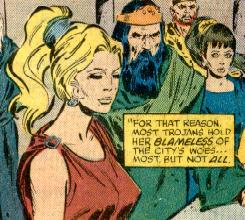
HELEN OF TROY

Real Name: Helen
Identity/Class: Demi-goddess
Occupation: Goddess of beauty and perfection, former monarch
Group Membership: Venus' handmaidens (including Bilitis, Cleopatra, Du Barry, Circe, Isolde, Juliet, Liti, Psyche, Salome, unidentified others),
Affiliations: Olympian gods, Paris, Maria Storm, Trojan forces at Troy
Enemies: Achilles and the Greek armies, Megapenthes, Nicostratus, Odysseus, Orestes, Polyxo and her maids
Known Relatives: Zeus (father), Leda (mother, deceased?), Tyndareus
(foster father), Menelaus (estranged husband), Catreus (father in law,
deceased), Polydeuces (brother, alias Pollux, deceased?), Castor (half-brother,
deceased), Clytemnestra (half-sister, deceased), Pleisthenes (son, deceased),
Hermione (daughter, deceased), Molossus (son in law, deceased), Orestes
(nephew/son in law, deceased), Tisamenus (grandson, deceased), Heracles,
Apollo , Ares, Hephaestus
, Hermes
, Dionysus (half-brothers),
Artemis
, Athena
, Venus
, Eris, Eileithyia, Hebe, Pandia (half-sisters)
Aliases: Pandia? (see Comments)
Base of Operations: Olympus; formerly ancient Sparta (now part of modern Greece), formerly Troy (now part of modern Turkey)
First Appearance: Venus#1 (August, 1948)
Powers/Abilities: As a goddess, Helen possesses several attributes
of the Olympian Gods such as superhuman strength (Class 20 at least), longevity,
vitality, resistance to harm and eternal life just so long as she ate ambrosia
and drank nectar made from the apples of immortality. She might have limited
mystical skills to at least cross barriers between dimensions and possibly even limited clairvoyance.
As a mortal, she had none of these powers except for her Olympian beauty and perfection.
History: Helen grew up to be particularly beautiful and
her mortal guardian King Tyndareus sought to prevent bloodshed by forcing her
suitors to exacting a vow of non-violence and by standing by the side of Helen’s
husband to protect her. King Theseus of Athens and his close friend, Peirithous,
Leader of the Lapith tribes, however, had both made vows to marry daughters of
Zeus. While Helen was only twelve years old, Thesus abducted from her Sparta and
left her in the custody of his mother in Aphidnae. While Theseus and Peirithous
left to kidnap Persephone from the Underworld, Castor and Pollux invaded
Aphidnae, rescued Helen and left the throne in the hands of Theseus’s enemies. Helen’s sister, Clytemnestra, was taken by King
Agamemnon of Mycenae which left Tyndareus without a successor to his throne. He
betrothed Helen to Agamemnon’s brother, Menelaus, who then replaced him on the
throne of Sparta. Helen, however, ended up promised to Paris, a prince of Troy,
by the goddess Aphrodite. While Menelaus was absent for the funeral of King
Catreus, Paris spirited Helen out of Sparta and took her to Troy. Menelaus on
his return called the kings and warriors on their vow to Tyndareus and declared
war on a ten-year battle to be called the Trojan War. (Thor Annual I#8)- Lost in time and space in the
caves under Asgard, the Asgardian God Thor befriended Dardanian prince Aeneas
and fought with him to defend Troy against the hordes of Greek armies. During
his combat, he had a brief glimpse of Helen watching the war from the towers of
Troy. Loki, the god of mischief, was also lost in that time and gave Odysseus the idea for the Wooden Horse. (Greek Legend)- Helen somehow realized the
Greeks were hiding in the horse and tried to dissuade them from more bloodshed
but they ignored her. After Paris’s
death, Helen was abducted by his brother as a concubine, but Paris' brother was killed by
Menelaus who had secured his way past the Trojan walls inside the Wooden Horse.
Menelaus also wanted to kill Helen for her role in the war, but could not bring
himself to carry through the act. Aphrodite then instructed Hermes to spirit
Helen to Egypt where she was hid from Menelaus by King Proteus. Menelaus tracked
her there from advice given him by Athena. Proteus removed Helen’s memories of
the war with water from the river Lethe as she returned to Menelaus. In the aftermath of Agamemnon’s death,
Menelaus’s nephew Orestes came to him for absolution in the murders of his
mother and her lover. Refused a defense, he tried to kill Helen for the grief
caused in her wake and Aphrodite again advised Hermes to spirit her off this time to Olympus. Helen meanwhile desired to return to Menelaus,
but after his death, she was driven from Sparta by her step-sons Nicostratus and
Megapenthes. She fled to Rhodes to live with Polyxo, one of the widows from
Troy, who saw her and realized this was her chance to avenge her husband. She
instructed her maids to impersonate Erinnyes, goddesses of punishment, and to
slay her, but Aphrodite rescued Helen again and the maids had to fabricate a
murder for Helen’s absence. Believing Helen was dead, the Spartans placed a
marker in her name next to Menelaus’s tomb. (Venus#1/2) <During the 1950s> - To prove her worth as an editor to Whitney Hammond, Venus recruited ten of her handmaidens---including Cleopatra, Helen
of Troy, and Salome---to come to Earth as part of a Beauty Magazine project
focusing on beautiful women, thus beating the line-up in their rival publication Lovely Lady Magazine. (Venus#9/5) - Venus summoned at least 14 of her handmaidens, including Cleopatra, Juliet, Du Barry, Helen of Troy, Isolde and Circe, to Earth to answer letters sent to Beauty Magazine by women in search for their own beauty. The next morning after a long night of work the handmaidens returned to the home of the gods. (Venus#11/1) - When Michael Templar's machine threatened to plunge Earth into the sun, Helen of Troy was among Venus' handmaidens who bestowed their beauty to Templar's lab assistant, the plain Maria Storm; upon seeing the transformed Maria, Templar fell in love with her and reversed the machine, sparing the world. Comments: Adapted by Ken Bald and George Klein. This history obviously merges the many accounts
of Helen’s demise and death with the scenario that she became a goddess. In some references, Helen is identified as the
same personage as Pandia, the goddess of beauty, who is otherwise described as
the daughter of Zeus and Selene, the moon-goddess.
Some references also claim that Helen and
Pollux were the children of Zeus and Nemesis, the goddess of vengeance. One
version tries to make an allowance for this by claiming Leda later became the
goddess Nemesis. Casts sort of a weird spin on those “Hercules: The Legendary
Journeys” stories, doesn’t it? Some myths claim that after the birth of
Hercules that Zeus swore off seducing mortal women, but then this doesn’t
explain Helen’s divine birth. It could be assumed that Zeus actually made this
promise after Hercules had become a god and Helen was already born.
Historically, the Ancient Greeks attacked Troy
for control of the Hellespont, a waterway leading to the Black Sea. It was a
confrontation even participated by Hercules and the Argonauts after Hercules was
refused the hand of Hesione by Priam’s father, Laomedon. Hercules even placed
Priam on the throne after slaying Laomedon. In any rate, Menelaus almost
definitely used the abduction as his wife as an excuse to further attack Troy.
Actually, when you think about it, the Greeks had a lot going against them in
the war. They were fighting on a foreign soil, many of them spoke different
languages ranging from Achaean, Ionian, Dorian, Aeolian and others and many of
them had already hated each other’s guts. Athens and Crete
had just staved off hostilities just barely twenty years earlier. It is perfectly acceptable that Cleopatra served Venus since she was of Greek descent and only lived in
Egypt, but Salome was a Hittite who lived in Palestine while it was under Roman rule. A very interesting version of Helen’s lifetime
was depicted in the excellent movie “Helen of Troy (2003) starring Sienna Guillory, but
even that movie takes numerous liberties with the actual story. Thanks to Ron Fredricks for adding Helen's appearance in Venus#11. Thanks to Gammatotem for pointing out her appearance in Venus#9 (and Markus Raymond for adding it). Profile by Will U CLARIFICATIONS: Appearances:
First Posted: 11/21/2003 Any Additions/Corrections? please let me know.
Non-Marvel Copyright info Special Thanks to www.g-mart.com for hosting the Appendix, Master List, etc.!

(Greek Legend)- Helen is the daughter of Zeus and the
Calydonian princess, Leda, a wife of King Tyndareus of Sparta. Leda had a vision
of her pregnancy in which a swan bestowed her four eggs out of which sprang her
four children. Spartan priests translated the dream by claiming it meant that
some of her children were going to be of divine birth.
Helen of Troy should not be confused with:
Venus#1 (August, 1948) - Lin Streeter (artist)
Venus#9 (May, 1950) - Werner Roth (pencils), Stan Lee (editor)
Venus#11 (November, 1950) - unidentified writer, Werner Roth (pencils and inks), Stan Lee (editor)
Thor Annual I#8 (1979) - Roy Thomas (writer/editor), John Buscema (pencils), Tony DeZuniga (inks), Roy Thomas (editor)
Last updated: 04/13/2019
All other characters mentioned or pictured are ™ and © 1941-2099 Marvel Characters, Inc. All Rights Reserved. If you like this stuff, you should check out the real thing!
Please visit The Marvel Official Site at: http://www.marvel.com